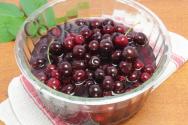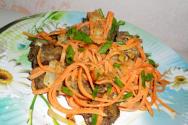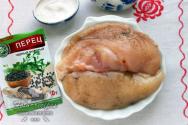Carrot caviar for the winter - a simple recipe. Carrot caviar for the winter Simple recipes for carrot caviar for the winter
How often do you cook dishes where carrots are the main ingredient? Usually it is used only as an additional, auxiliary vegetable in various recipes for soups and borscht, all kinds of stews. But this vegetable is underestimated, limiting it to such a narrow range of uses, because it has such a unique, sweetish taste! Just think about the incredibly appetizing one, and what can we say about carrot caviar!.. Don’t pass by this recipe, because you will discover this vegetable from a new side and fall in love with it.
The taste of carrot caviar is difficult to compare with something specific. In general, it resembles all types of vegetable caviar, but is distinguished by its depth of taste, sweet and sour taste, and strong aroma. This caviar is prepared in three stages, which makes it incredibly delicate in texture. First, a sauce is prepared from tomato paste and onions, in which the carrots will be cooked. The carrots themselves are fried in a small amount of oil, and then sautéed by adding water. The last stage is simmering the caviar in the oven at low temperature. The last stage brings together all the tastes and aromas.
This carrot and onion caviar can be prepared several times, or you can use the recipe to prepare this snack for the winter.
Ingredients
- 500 grams of carrots
- 250 grams of onion
- 0.5 cups tomato paste
- 0.5 cups vegetable oil
- 2-3 bay leaves
- 2 cloves garlic
- salt, black and allspice peas - to taste
Yield of finished product: 600-650 grams
Recipe for carrot caviar with onions
First, dilute the tomato paste with water so that it has the consistency of low-fat sour cream. Pour the tomato into a small saucepan.

Grind black and allspice in a mortar.

Add peppers to tomato mixture. Add bay leaf there too.

Pour in the vegetable oil, reserving a couple of tablespoons for frying the carrots. Stir.

Finely chop the onion.

Add the onion to the tomato base. Place the pan on the heat and simmer the sauce until the onion is soft.

During this time, grate the carrots on a fine grater.

Fry the carrots in the remaining vegetable oil for 4-5 minutes, stirring. Cook over medium heat. Then add water little by little and cook until the carrots soften.

By this time, the tomato sauce should have reached the desired degree of readiness, the liquid will evaporate slightly and it will thicken.

Peel the garlic cloves and grind with salt to a paste.

Add garlic paste to tomato sauce. Send carrots there too. Mix thoroughly.

Place the carrot mixture in a fireproof bowl, cover it with foil and place in the oven, heated to 160 degrees. Let it simmer for 30-35 minutes.
If you can preserve caviar from carrots and onions for the winter, then place it hot in sterile jars and seal it. Store the remaining carrot caviar in the refrigerator for a week.

Squash and eggplant caviar is prepared for the winter in almost every home. But these are not all vegetables suitable for preparing caviar. Incredibly tasty caviar can be made, for example, from beets or tomatoes. Squash caviar for the winter or carrot caviar for the winter will turn out to be no worse than standard ones, more original, bright and tasty.

It is customary to preserve the juicy root vegetable in the form of ordinary preparations for borscht. But few people know that you can make incredibly tasty caviar from it. It can be served with side dishes or spread on bread.
You will need:
- a couple of kg. beets;
- 1 kg. sweet pepper;
- 3 kg. very ripe tomatoes;
- 3 heads of early garlic;
- two hundred gram glass of butter;
- 1 tbsp. l. salt;
- 50 gr. greenery
Beetroot caviar for the winter recipe:
- Beets must be washed and peeled. After this, it must be ground using a regular meat grinder.
- The chopped root vegetable is fried in oil. This process lasts about half an hour.
- The pepper is washed and all the seeds are carefully removed from it. Like beets, they are ground in a meat grinder and added to the root vegetable simmering in a frying pan. The frying process drags on for another hour.
- The tomatoes are immersed in boiling water for a few seconds, after which the skins are easily removed. The tomatoes are crushed into puree, again using a meat grinder.
- Tomato puree is poured into vegetables and salted. The mixture simmers for another hour.
- A quarter of an hour before the completion of this process, chopped garlic and herbs are added to the caviar.
- The container for preservation is prepared, washed with soda and subjected to the necessary sterilization.
- Still very hot caviar is placed in thermally treated jars and immediately rolled up.
Simple recipe for winter squash caviar

Squash is ideal for preparing caviar. Unlike ordinary zucchini, they do not have huge seeds, they are juicier and more tender. The dish turns out not only fresh, summer-like, aromatic, but also airy.
You will need:
- one and a half kg. squash;
- half kg. Luke;
- 4 tbsp. l. tomato paste;
- 1 tsp. vinegar;
- quarter 200 gr. glasses of butter;
- 1 tbsp. l. salt;
- third tsp ground regular pepper.
Vegetable caviar for the winter through a meat grinder:
- The squash must be washed, cut and baked until fully cooked in a conventional oven. Baking is a faster process than frying. This makes the vegetables much more tender and flavorful.
- Slightly cooled squash is ground in a regular meat grinder or blender.
- The onion is peeled and chopped very finely.
- The chopped onion is placed in a frying pan with the oil as hot as possible, tomato paste is added to it and fried a little.
- The prepared tomato mixture is added to the chopped squash.
- The caviar is stewed for at least half an hour over low heat until it thickens.
- A few minutes before it is ready, salt, pepper and add vinegar.
- The container for canning is prepared, washed with soda and subjected to the necessary sterilization.
- The finished product is placed in heat-treated jars and immediately rolled up.
- The jars should cool upside down and covered with something warm.
Caviar from tomatoes and peppers for the winter

The unusual taste of caviar is given by a combination of vegetables such as zucchini and eggplant. They are often used separately, but their tandem works wonders. This kind of caviar disappears from the plates of even the most capricious children.
You will need:
- half kg. small eggplants;
- half kg. young zucchini;
- half kg. sweet pepper;
- one and a half kg. tomatoes;
- half kg. Luke;
- a couple of cloves of early garlic;
- floor l. oils;
- 1 tsp. vinegar essence;
- third tsp ground regular pepper;
- a couple of st. l. salt.
Vegetable caviar for the winter recipe through a meat grinder:
- The eggplants must be washed and cut lengthwise into several pieces. To get rid of their inherent bitterness, you should soak them in slightly salted water for about half an hour, then wipe until dry.
- The remaining vegetables are naturally washed too.
- Peel the skin from the zucchini.
- All seeds are carefully removed from the pepper.
- Tomatoes are cut into a pair of equal parts.
- All prepared vegetables are transferred to a special baking sleeve.
- The filled sleeve is tied and placed in a preheated oven, where the vegetables should remain for about half an hour.
- All skins are removed from the onion and it is cut into small cubes.
- The carrots are peeled and grated.
- In a frying pan, heat the oil as high as possible and add chopped onions and carrots. They should be fried until they become soft.
- A sleeve with baked vegetables is removed from the oven.
- Remove the skin from slightly cooled tomatoes.
- All vegetables are chopped using a regular meat grinder.
- The vegetable mixture is transferred to a container suitable for further actions, oil is added to it and simmered for at least half an hour with very frequent stirring.
- The caviar is removed from the heat and mixed with salt and pepper. After which it cooks for the same amount of time.
- In the last minutes of cooking, chopped garlic and vinegar are added to the caviar.
- The container is prepared for further canning, it is thoroughly washed with soda and subjected to the necessary sterilization.
- Still very hot caviar is transferred into jars that have undergone heat treatment and immediately rolled up.
- It is better for such caviar to cool upside down and covered with a blanket.
Important! Roasting vegetables is good not only in terms of speed of preparation. Such vegetables retain much more useful substances, which simply evaporate when boiled or fried. By baking vegetables, you can avoid adding excess fat to the product, which means the dish turns out to be less high in calories and lighter. And the aroma of such vegetables is different, rich.
Carrot caviar recipe for the winter

One of the most delicious dishes that can be prepared from a healthy orange root vegetable is, of course, caviar. It turns out incredibly aromatic, with a pleasant sweet and sour aftertaste. You should definitely take care of the availability of such a preparation, even despite the fact that there are no problems with this vegetable in winter. Young, juicy carrots will be ideal for preparing this excellent dish.
You will need:
- 1 kg. juicy carrots;
- half kg. sweet pepper;
- 1 hot pepper;
- one and a half kg. tomatoes;
- quarter kg. Luke;
- a couple of st. l. salt;
- quarter 200 gr. a glass of vinegar.
Carrot caviar for the winter simple recipes:
- Young carrots must be washed and peeled, after which they are slightly dried and chopped in a regular meat grinder or blender.
- Peppers, sweet and bitter, are naturally also washed, all seeds are carefully removed and chopped in the same way as carrots.
- Tomatoes are literally immersed in boiling water for a few seconds, after which the peel is easily removed. A sieve is used to puree them. All tomatoes are actively ground through it.
- The existing peel is removed from the onion and then chopped into miniature cubes with a knife.
- All prepared vegetables are transferred to a container suitable for further actions and boiled for half an hour. In this case, you should stir them continuously.
- After half an hour, salt is added to the vegetable mixture and the vegetables simmer for about ten more minutes.
- The container is prepared for further preservation; it is washed with soda and subjected to the necessary sterilization.
- Still very hot caviar is placed in heat-treated jars, vinegar is poured in and immediately rolled up.
Carrot caviar for the winter through a meat grinder

Any housewife has a huge number of jars with different variations of canned tomatoes in her bins. But you shouldn’t stop there, because you can also prepare caviar. This is a universal dish that can be added to borscht, and making a sauce from it is not difficult. And in itself it will give odds to ketchups, adjika and even the most exquisite lecho.
You will need:
- 3 kg. tomatoes;
- a couple of kg. juicy carrots;
- 1 kg. Luke;
- a couple 200 gr. glasses of butter;
- a couple of st. l. vinegar;
- 1 tsp. ground regular pepper;
- 5 laurel leaves.
Carrot caviar recipe for the winter through a meat grinder:
- First of all, the container is prepared for further canning; it is washed with soda and subjected to the necessary sterilization.
- The existing peel is removed from the onion and it is chopped into miniature cubes with a knife.
- Carrots must be washed and peeled. Then it needs to be cut into tiny cubes.
- The tomatoes are immersed in boiling water for a few seconds, after which the skin is easily removed.
- Peeled tomatoes are randomly chopped and crushed using a regular meat grinder.
- Tomato puree is mixed with chopped carrots and onions, spices, oil and naturally salt.
- Boil the vegetable mixture and cook for at least two hours with frequent stirring.
- A couple of minutes before the end of cooking, vinegar is added to the caviar.
- The finished caviar, while not yet cooled, is transferred to warm jars and immediately rolled up.
Important! During the cooking process of any caviar, you should not forget to constantly stir the vegetable mixture. A little forgetfulness and instead of a tasty dish you may end up with burnt mush. You will hardly want to eat such caviar, much less preserve it.
Canned vegetables should not be limited to pickles and marinades. For the winter, beet caviar through a meat grinder must be stored on shelves. Their amazing taste combined with a huge amount of vitamins makes the product simply priceless. This excellent, unusual snack makes you remember the warmth and sunny summer even in a snowstorm and cold. In addition, caviar is also a low-calorie product, especially if the vegetables have been baked, so you can eat it in unlimited quantities.
Carrot caviar is an excellent appetizer that can be eaten either on its own or as an addition to a variety of meat dishes. Carrot caviar is especially relevant in winter, because it is prepared from vegetables rich in vitamins. To enhance the taste, sweet or hot peppers, garlic, tomatoes or tomato paste are added to the caviar.
You can experiment with spices, each time giving the preservation a special taste. The recipe uses virgin sunflower oil, which gives carrot caviar a pleasant aroma. If you like unusual combinations, you can add 1 tsp to the caviar. aromatic flaxseed oil, which will make the taste of the dish even more rich.
| Name: | Carrot caviar | |
| Date added: | 11.02.2017 | |
| Cooking time: | 1 hour 10 min. | |
| Recipe servings: | 6 | |
| Rating: | (No rating) |
Carrot caviar recipe
Wash the carrots, peel and grate on a coarse grater. Peel the onion, cut into four parts and cut into small cubes. Rinse the tomatoes thoroughly under running water and cut into small cubes. Rinse the bell pepper with water, cut in half, remove the stem and seeds, and cut the pulp into small cubes.
Peel the garlic from films and husks, and then grate on a fine grater or pass through a press. Heat a deep frying pan high, add 1 tablespoon of sunflower oil and fry all the vegetables for ten minutes. Vegetables must be fried over high heat so that the moisture evaporates quickly.  Carrot caviar can be used both as a separate appetizer and as a full-fledged vitamin salad. Then reduce the heat to minimum and simmer the vegetables under the lid for twenty minutes. Add salt, pepper mixture and hot pepper. Mix thoroughly. After the specified time has passed, pour the remaining sunflower oil into the pan and simmer the vegetables under the lid for another five minutes. Next, start sterilizing the jars.
Carrot caviar can be used both as a separate appetizer and as a full-fledged vitamin salad. Then reduce the heat to minimum and simmer the vegetables under the lid for twenty minutes. Add salt, pepper mixture and hot pepper. Mix thoroughly. After the specified time has passed, pour the remaining sunflower oil into the pan and simmer the vegetables under the lid for another five minutes. Next, start sterilizing the jars.
Place the jars and lids in the steamer tray and heat at maximum steam for ten minutes. You can also sterilize jars in the oven or in a pan of boiling water. Place the finished caviar into jars and roll up the lids. Cool the carrot caviar at room temperature, after wrapping each jar with a blanket or towel.
 If you are tired of the monotony of prepared dishes and are not at all averse to experimenting, then prepare carrot caviar! This appetizer turns out to be moderately spicy and so tasty that you will not be able to stop after trying the first spoon of this dish. Carrot caviar will be an excellent aperitif instead of a regular salad, especially in winter, when there are no traces of fresh vegetables. You can also preserve it for the winter if, after grinding, add a little 9% vinegar to the caviar and simmer it on the stove for about 5 minutes, then transfer it to sterilized containers and seal it.
If you are tired of the monotony of prepared dishes and are not at all averse to experimenting, then prepare carrot caviar! This appetizer turns out to be moderately spicy and so tasty that you will not be able to stop after trying the first spoon of this dish. Carrot caviar will be an excellent aperitif instead of a regular salad, especially in winter, when there are no traces of fresh vegetables. You can also preserve it for the winter if, after grinding, add a little 9% vinegar to the caviar and simmer it on the stove for about 5 minutes, then transfer it to sterilized containers and seal it.

Ingredients
- Carrots - 400 g
- Garlic - 5 cloves
- Salt - 3 pinches
- Vegetable oil- 20 ml
- Ground black pepper- 2 pinches
- Water - 100 ml
Information
SnackServings - 4
Cooking time - 0 h 25 min

How to cook
Peel the carrots and rinse in water. By the way, the most delicious caviar comes from young and juicy carrots. Pour vegetable oil into a saucepan or frying pan with high sides. Cut the carrots into small pieces and pour the slices into a saucepan and place it on the stove.
Pour vegetable oil into a saucepan or frying pan with high sides. Cut the carrots into small pieces and pour the slices into a saucepan and place it on the stove.
 Add salt and ground black pepper, fry in well-heated vegetable oil until soft, about 5-10 minutes.
Add salt and ground black pepper, fry in well-heated vegetable oil until soft, about 5-10 minutes.
 Add hot water. Peel the garlic cloves, rinse them in water and press directly into the saucepan. Gently mix and simmer the carrot slices until tender (about 10 minutes), covering the container with a lid. If desired, you can add a couple of bay leaves to it.
Add hot water. Peel the garlic cloves, rinse them in water and press directly into the saucepan. Gently mix and simmer the carrot slices until tender (about 10 minutes), covering the container with a lid. If desired, you can add a couple of bay leaves to it.
 As soon as the cuttings become soft, pour them into a deep blender container and grind for 3-5 minutes, not forgetting to add water if there is not enough broth and the mass turns out thick. Let's taste the caviar, and if you don't have enough spices, you can add them at any time.
As soon as the cuttings become soft, pour them into a deep blender container and grind for 3-5 minutes, not forgetting to add water if there is not enough broth and the mass turns out thick. Let's taste the caviar, and if you don't have enough spices, you can add them at any time.







